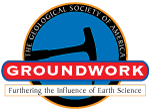Abstract View
Volume 27 Issue 11 (November 2017)
GSA Today
Article, pp. 8–9 | Full Text | PDF (2.1MB)
GROUNDWORK:
The Great Acceleration and the Disappearing Surficial Geologic Record
1 Department of Geology and Environmental Earth Science, Miami University, Oxford, Ohio 45056, USA
2 U.S. Geological Survey, Denver Federal Center, Box 25046, MS-980, Denver, Colorado 80225, USA
The surficial geologic record is the relatively thin veneer of young (<~1 Ma) and mostly unconsolidated sediments that cover portions of Earth’s terrestrial surface (Fig. 1). Once largely ignored as “overburden” by geologists, surficial deposits are now studied to address a wide range of issues related to the sustainability of human societies. Geologists use surficial deposits to determine the frequency and severity of past climatic changes, quantify natural and anthropogenic erosion rates, identify hazards, and calculate recurrence intervals associated with earthquakes, landslides, tsunamis, and volcanic eruptions. Increasingly, however, humans are eradicating the surficial geologic record in many key areas through progressive modification of Earth’s surface.
Manuscript received 31 March 2017. Revised manuscript received 15 July 2017. Manuscript accepted 24 July 2017. Posted online 20 Sept. 2017.
10.1130/GSATG341GW.1
©2017, The Geological Society of America.

